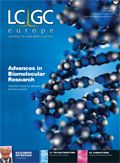Icons of Chromatography: John Knox
Rising stars interview leading figures in the world of chromatography. Gert Desmet talks to John Knox.
Gert Desmet: What brought you to the field of chromatography?
John Knox: I got into chromatography along with my great friend Howard Purnell in 1953. We were both PhD students working under R.G.W. Norrish at Cambridge. I was studying hydrocarbon combustion and Howard was investigating hydrocarbon pyrolysis. The analytical methods at the time were very primitive so trying to determine the mechanisms of these complex processes by analysis of the end products was actually a hopeless task. Nevertheless, the experiences in the Physical Chemistry Lab (PCL) started us both on our careers in gas kinetics and chromatography. It all started with my job interviews at ICI, first at Billingham, where Bradford, Harvey and Chalkley had just built a gas chromatograph that they were very excited about. Unfortunately, they could only show me the heating jacket for the column, which was a tube about 1 inch in diameter and 1 metre long wound with heating wire. I was interviewed at the Alkali Division where they made polyethylene by the high pressure process. The research director, Ray Richards, explained that a key analysis was the determination of traces of acetylene in ethylene because acetylene inhibited the process.

Image Source/Getty Images
He said: "We have this chap Ray (Neil Ray) who has found out how to do this. He uses a thermal conductivity gauge. I have no idea how it works" It all clicked together. This was gas chromatography. It used a column about 1 metre long packed with adsorbent material, samples were injected into the column and as the different components emerged they were detected by a catharometer.
Howard and I talked about this over a beer in the local bun shop. Within a few days we had a working GC with a catharometer that used the filament taken from an electric light bulb. Quite soon we could separate all the simple hydrocarbons. We wrote a paper, sent it to the Faraday Society. We explained how band spreading was determined by slow equilibration and how retention decreased as the temperature rose. We then proposed that analysis of a range of materials with a wide range of volatility could be speeded up by increasing the temperature as the analysis proceeded — temperature programming. The paper was rejected as being too speculative! This was just a year after Martin and James' famous paper and a year before Ray's important paper in 1964.
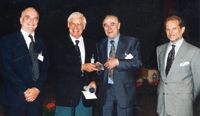
John Knox being presented with the Golay Medal by Ernst Beyer at the Lake Garda meeting of Capillary Chromatography in 2000.
GD: Who did you collaborate with most during your scientific career?
JK: I was always more of a loner than collaborator, but I was greatly influenced by many of the pioneers in chromatography. I met Jack Kirkland initially at the first Houston Conference organized by Al Zlatkis, I think it was 1958 and we became long-term friends. These conferences were an inspiration and a huge stimulation, especially for a young scientist on his early visits to the USA. It was in Houston that I met Cal Giddings and was enormously impressed by his grasp of the dynamics of chromatography — later to be the subject of his book.
This led to a sabbatical with Cal in Utah — January to September 1964. I wanted to test his theory of the coupling of the two dispersion processes: eddy diffusion and slow mass transfer. To test this required that experiments be conducted at high "reduced velocities" (u dp/Dm). This meant using a liquid as the eluent, not a gas. This introduced me to column liquid chromatography with a post-column photometric detector. Subsequently, in 1969, I published a landmark paper with Mohammed Saleem, which suggested that the highest speed in LC would be obtained by using 2 micron porous particles.
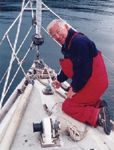
Sailing on: JHK demonstating the device he invented for monitoring anchor loading: Anchorwatch. (Photo courtesy of John Knox)
Jack said some years later that this pointed him to the invention of the fully porous 5 micron Zorbax particles. Later through Jack's suggestion I was appointed a consultant to Du Pont and the company supported as a PDF at Edinburgh, which was taken up by John Done. We did a lot of work on dispersion with columns packed with Jack's pellicular material Zipax, and later George Laid continued this work using 20 micron spherical alumina particles that had been developed by Harwell using their Sol-Gel process for encapsulating nuclear waste. These materials proved excellent for LC. I suggested to Roy Nelson who was the research director at the time — and one of my former students — that it would be a good idea to make similar particles of silica gel, which was much more widely used in LC than alumina. This resulted in an excellent spherical silica gel, which later became marketed by Phase Separations as Spherisorb.
This was the start of many studies on dispersion and led to what is now known as the Knox equation. In 1972 I made a proposal to the Wolfson Foundation to support a project under their scheme linking University Research with Industry, which aimed to commercialize instrumental LC in the UK. We were lucky to be awarded a substantial grant. After a false start we gained the interest of Shandon Southern Products in the idea. This led to a long collaboration with Shandon and its successors. We developed an advanced HPLC instrument coupled with a range of packing materials marketed under the tradename Hypersil. These were developed in my Wolfson Liquid Chromatography Unit in Edinburgh by Andrew Pryde.
The collaboration became particularly fruitful when John Dolphin took over as managing director at Hypersil and was continued with his successor Harry Ritchie, another of my research students. During this period Mary Gilbert and Bulvinder Kaur developed an entirely new chromatographic packing material, which we called porous graphitic carbon or PGC. This was commercialized by Shandon's successor Hypersil Ltd and marketed as Hypercarb. Over this long period I had many discussions with the leaders in LC, in particular Josef Huber, Lloyd Snyder, Istvan Halasz, Hans Poppe, Barry Karger and many others. They all influenced my research in very positive ways and led to improved understanding of exclusion chromatography, ion-pair chromatography, preparative LC and band dispersion.
I also had the privilege of working with Klaus Unger in Mainz in 1981 after we had independently developed graphitic carbon packings. Around 1972 a number of us including Jack Kirkland and Josef Huber felt that the current series of meetings under the auspices of the Gas Chromatography Discussion Group and GAMS paid too little attention to liquid chromatography. As a result the series of International Symposia on Column Liquid Chromatography was initiated in alternate years with its inaugural meeting in Interlaken chaired by Josef Huber.
GD: What do you see as your major contribution to the field?
JK: I think that my most important contribution in the early days was the early application of gas chromatography to gas reaction kinetics where I was one of the first — if not the first — to obtain rate constant data using GC, and thereby able to unravel mechanisms of combustion and chlorination reactions. But most people working in the field of chromatography will probably associate me with the Knox equation, which relates band dispersion in chromatography to the linear eluent flow-rate, particularly in LC. This equation arose from the work of George Laird on the Harwell spherical aluminas. Later, in this area Hugh Scott and I wrote a key paper, which showed that Giddings analysis of band spreading was quantitatively precise. Hugh's work confirmed that the major part of band spreading in LC arose from the irregular flow in the mobile zone and not slow mass transfer in the static zone.
It also showed that the Knox equation was a gross oversimplification. The so-called C-term in this equation was not a true measure of the band spreading from slow mass transfer in the stationary zone (i.e., the particles themselves) but mostly contributed by processes occurring in the mobile zone (the fluid outside the particles). Subsequently, the development of porous graphite in the late 1970s was, I believe, an important contribution. Graphite with its uniform crystalline surface should be the ideal chromatographic packing material. Unfortunately, it has not taken off as I had hoped, but good things often take time to be appreciated! Subsequently, after the breath-taking paper delivered by Jim Jorgenson at the Avignon meeting on electrophoresis and electro-chromatography, I became particularly interested in the amazing performance that could be obtained in electrically driven liquid chromatography, which uses electro-endosmosis as the driving force instead of pressure. Separations by this method mirror those of capillary gas chromatography. Again, this is a technique that has not been followed up as I would have hoped.
GD: What does it take to make a major scientific breakthrough? Perseverance? A flash of inspiration? Or luck?
JK: All of these things! Obviously perseverance is important to make any kind of scientific advance, especially when it is ahead of its time, but in many cases I was just following others where insight into the underlying principles was the key factor. Probably the most novel "invention" I made was porous graphite. Its production used a template of porous silica. The pores were filled with a carbonizable polymer; the polymer was carbonized under nitrogen; the silica was dissolved using potassium hydroxide and the final silica-free material was graphitized under vacuum to give the final "porous graphitic carbon". The final material had a high surface area and excellent chromatographic performance, matching that of the bonded silica gels.
GD: What finding surprised you most?
JK: I do not think I have a candidate for this. Scientific research is always exciting, but it is the perseverance to get through disappointing periods that is probably the key to ultimate success. Undoubtedly the success of the porous graphite project was the most surprising, originating as it did from momentary inspiration. What amazed me was the way in which Mary Gilbert took my idea and in a remarkably short time came up with a product that worked. When we obtained the Wolfson Foundation grant, our first task was to develop a commercially viable HPLC system and the accompanying bonded chromatographic packings. Andrew Pryde, who sadly died from diabetes some 10 years later, had the job of developing the packing materials. Andrew developed a method of making 5 micron porous silica particles and then how to bond them to make ODS, TMS, cyano and ion exchange silicas. Andrew was an exceptional organometallic chemist and he seemed to have an instinctive understanding that enabled him to develop these materials without performing endless trials and experiments. These were talents which I did not have!
GD: What was your biggest mistake?
JK: I was fortunate in not pursuing too many dead-enders! Maybe it was caution in taking up topics that others had started and that looked promising and interesting. Actually the most fruitless research, in terms of contribution to science, was probably my PhD project into the low temperature combustion of propane. Although it was a fascinating project, the analytical methods available at the time (1949–53) were so crude that end-product analysis for functional groups, olefins, aldehydes, alcohols, peroxides was a hopeless method of uncovering the mechanism of such a complex process. The good news was that the mutual discovery of GC by Howard Purnell and myself revolutionized all this and set us off on our careers, when we were both able to make positive and valuable contributions to these subjects where we had struggled in Norrish's lab. While my subsequent research into hydrocarbon combustion made some important advances, it all came to a grinding halt when I realized, reluctantly, that most of the combustion products that we had been so carefully analysing over the years were actually formed on the walls of our glass reaction vessels, and not homogeneously as we had assumed. We had been working for years under a colossal misconception! It was at this stage that I side-stepped gas kinetics and put all my efforts into HPLC.
GD: What problem would you have liked to have solved yourself, but you did not have the time, funding or chance to be involved with?
JK: I do not have any real regrets. At one stage I became interested in using shock tubes for studying fast reactions, but I soon realized that my lack of understanding of spectroscopy made this impossible. In retrospect I would like to have been more involved in atmospheric kinetic studies, now so important in understanding global warming, but again this required a knowledge of spectroscopy, which I did not possess.
I have never really had problems with funding. My research did not require massive funding. We made all our GC and LC instruments. We never bought either a GC or LC instrument because most of the commercial instruments did not provide the flexibility necessary to do the experiments I was interested in. The work I did with Jadwiga Jurand in bio-metabolites of drugs could undoubtedly have been extended if we had had the funding, contacts and opportunities. Similarly, methods such as LC–MS would have provided exciting opportunities. But, sadly, I was not expert enough in these areas to be able to convince grant giving bodies to provide the cash. I was always more interested in the mechanistic side of chromatography than in its instrumentation. I was not really interested in doing the kinds of experiments that instruments dictated! In other words I was interested in the underlying principles rather than in the applications of chromatography.
GD: How do you see chromatography evolving and what do you think are the limits of chromatography?
JK: Chromatography and electrophoresis are simply methods of separating the components of mixtures. Mass spectrometry can identify the separated components. The future lies in scale reduction and increase in speed. I do not see great advances in principles. In the long run new analytical techniques will appear. Chromatography, electrophoresis and electrochromatography have to develop methods of analysing increasingly complex biochemical mixtures, particular proteins. DNA is relatively easy as there are only four nucleotides to be dealt with. The detection problem has been solved by fluorescent labelling. Proteins are far more complex with 26 amino acids to identify. The great challenge is now to determine the true mechanisms of biochemical reactions so that appropriate treatments can be developed, which are based on the understanding of the biochemical mechanisms rather than on trial and error. My generation tackled the mechanisms of gas and solution reactions but the tasks for the future are much more formidable. This is a colossal challenge, but success will lead to enormous medical advances. Chromatography and electrophoresis will play their parts, but entirely new methods will surely appear.
GD: Is there another profession you would have liked to devote your life to?
JK: Yes, I guess I might have made quite a good engineer. I have always been intrigued in how things work. Mechanical and structural engineering would certainly have been interesting. But had I stayed with physical chemistry I would like to have tried my hand at atmospheric modelling, which could have led to the study of global environmental problems and maybe some contribution to the current debate on the effects of CO2 and other gases on global warming. With such an important debate going on it is frustrating to be on the sidelines! But to achieve this I should have had to start again and learn the fundamentals of spectroscopy.
GD: What major challenge should the younger generation work on?
JK: The greatest problems for the next century will certainly be saving the environment. In this context energy production and population control will be the keys. Energy production, water supply and population control will have to move towards non-carbon sources. As the standard of living of world population increases the energy requirements will increase correspondingly. This becomes even more of a problem with the increasing world population. It has increased by a factor of FOUR in my lifetime! It seems likely that we shall have to expand our energy dissipation by a factor of between FIVE and TEN if all the world is to reach a standard of living approaching that of the western developed world.
As carbon fuels run out and become unacceptable, the generation of electricity will have to increase enormously. At the same time means of energy storage will have to be developed to cope with the inflexibility of nuclear power sources (which like to run at a constant load all the time) and the unpredictability of "renewables". Energy storage seems to be almost totally neglected at present. Contrary to popular misconception, only nuclear power will be able to expand sufficiently — first fission power and then fusion power. In a sobering analysis by David J.C. MacKay in his recent book Sustainable Energy — without Hot Air (ISBN978-0-9544529-3-3) he shows that renewables are too dilute and unpredictable to fill the gap. If we do not solve the energy problem we cannot cope with the burgeoning population problem. If humanity does not solve its problems within this century, nature will take its revenge through increasing conflict, wars, pestillence and famine as predicted by Malthus. Sadly, the development and handling of the recent predictable economic crisis does not bode well for the even greater crisis that will be posed by world climate and resource problems.
Our young people will have this legacy and they must not all fall for the green lobby's propaganda on energy matters. They must listen to Jim Lovelock whose early work on the flame ionization- and electron capture detectors led to his development of the Gaia theory, and his recent pessimistic predictions on the future of the earth's biosphere, and man's part in it. Our generation has messed up the environment and now the next generation have to clean it up before it is too late. They have to think scientifically about it and resist popular uneducated prejudice.
John H. Knox was a pioneer in gas chromatography and first demonstrated its use for quantification in the field of gas kinetics. In 1964 he performed early studies in the fundamental aspects of band spreading in liquid chromatography (LC) when on a visiting fellowship with Professor Giddings. This work formed the basis for the "Knox equation". In 1972 Knox was awarded a grant from the Wolfson Foundation, which initiated the Wolfson Liquid Chromatography Unit (WLCU). This lead to the development of the microparticulate packing materials for LC that are now marketed under the tradename Hypersil.
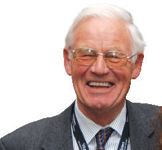
Photo courtesy of Professor Peter Myers from Liverpool University
An entirely new packing material was subsequently developed by WLCU called porous graphitic carbon (PGC). It is the only porous graphite that has become commercially available. Other developments made by Knox and his research group included early work on ion-pair chromatography, work on the separation of a range of drugs and metabolites with Jurand, advances in the theory of band spreading in exclusion chromatography with McLennan, in the theory of overloading in preparative chromatography and finally benchmark papers on capillary electrochromatography (CEC). Throughout his career Knox has been an innovator and a pioneer in the development of modern high performance chromatographic methods: gas chromatography (GC), high performance liquid chromatography (HPLC), capillary electrochromatography (CEC). He has been active in forming close contacts with commercial organizations, which have led to the development of a range of high quality commercial products. He became a Fellow or the Royal Society of Edinburgh in 1973 and of the Royal Society of London in 1984.
Ten years go he developed an instrument with colleague, Kevin Scott, to assist him with his passion for sailing in Scotland: Anchorwatch, which measures the hold on the anchor when anchoring and also alerts the crew when the hold on the anchor becomes too high. A new model is currently under development.
Gert Desmet obtained his PhD in chemical engineering (fermentation technology) from the Free University of Brussels, Brussels, Belgium, where he currently is a full professor in chemical engineering and heads the department of chemical engineering. In this capacity, he teaches courses on bioreactor design, on chemical reactor engineering, on nano- and microbiotechnology, and on chromatography in both the faculty of sciences and bioengineering and the faculty of engineering.
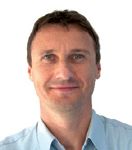
Gert Desmet
His research focuses on the miniaturization of separation methods and on the investigation and the modelling of flow effects in chromatographic systems.
Measuring Vitamin K1 Concentrations in Dogs with Chronic Enteropathy Using LC–MS/MS
May 14th 2025A joint study between the University of Tennessee (Knoxville, Tennessee) and the University of Pennsylvania School of Veterinary Medicine (Philadelphia, Pennsylvania) compared directly measured vitamin K1 (vitK1) concentrations in healthy dogs and dogs with chronic enteropathy (CE) using liquid chromatography tandem mass spectrometry (LC–MS/MS); they also investigated whether supplementation of vitK1 in dogs with CE would significantly increase vitK1 concentrations.
HPLC 2025 Preview: Fundamentally Speaking (Part 2)
May 14th 2025Michael Lämmerhofer from the Institute of Pharmaceutical Sciences, University of Tübingen, Germany, spoke to JFK Huber Lecture Award winner of 2024 Torgny Fornstedt, professor in analytical chemistry and leader of the Fundamental Separation Science Group, Karlstad University, Sweden, about his pioneering work in high performance liquid chromatography (HPLC) with a focus on fundamentals, ion-pair chromatography, and oligonucleotide applications.

.png&w=3840&q=75)

.png&w=3840&q=75)



.png&w=3840&q=75)



.png&w=3840&q=75)
